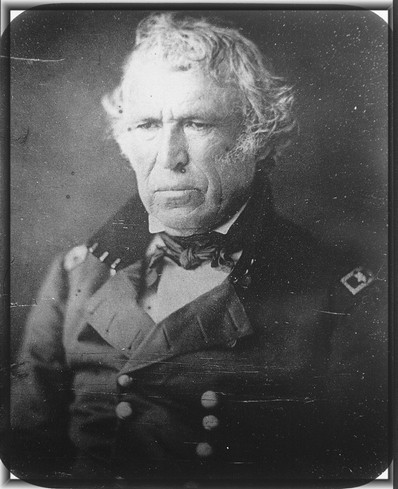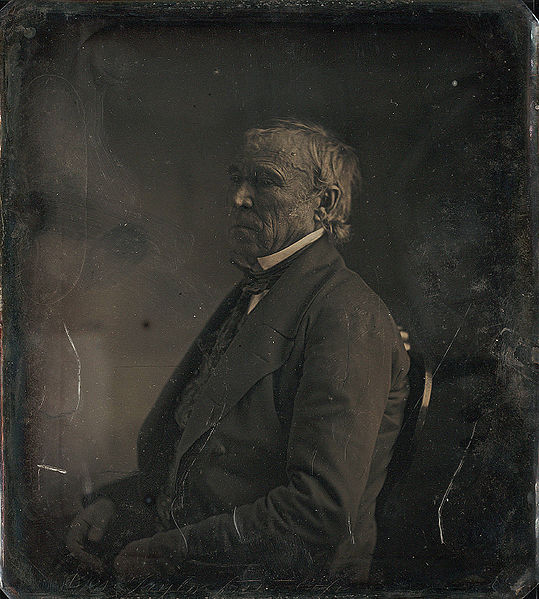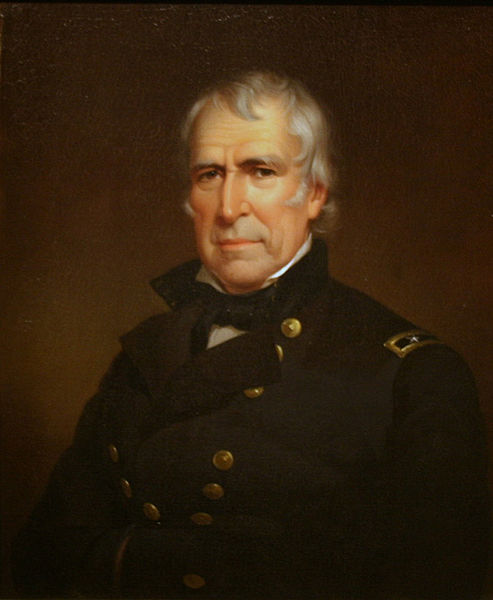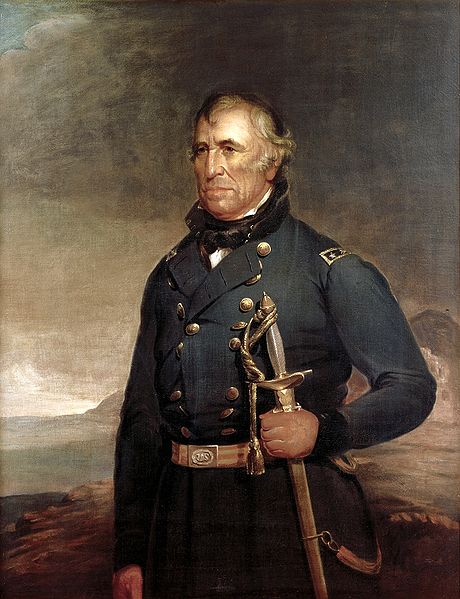<Back to Index>
- Physicist Tsung-Dao Lee, 1926
- Writer Carlo Lorenzini (Collodi), 1826
- 12th President of the United States Zachary Taylor, 1784
PAGE SPONSOR



Zachary Taylor (November 24, 1784 – July 9, 1850) was the 12th President of the United States (1849 - 1850) and an American military leader. Initially uninterested in politics, Taylor nonetheless ran as a Whig in the 1848 presidential election, defeating Lewis Cass. Taylor was the last President to hold slaves while in office, and the last Whig to win a presidential election.
Known as "Old Rough and Ready," Taylor had a forty year military career in the United States Army, serving in the War of 1812, the Black Hawk War, and the Second Seminole War. He achieved fame leading American troops to victory in the Battle of Palo Alto and the Battle of Monterrey during the Mexican – American War. As president, Taylor angered many Southerners by taking a moderate stance on the issue of slavery. He urged settlers in New Mexico and California to bypass the territorial stage and draft constitutions for statehood, setting the stage for the Compromise of 1850. Taylor died just 16 months into his term, the third shortest tenure of any President. He is thought to have died of gastroenteritis. Only Presidents William Henry Harrison and James Garfield served less time. Taylor was succeeded by his Vice President, Millard Fillmore.
Zachary Taylor was born on a farm on November 24, 1784, in Orange County, Virginia, to a prominent family of planters. He was the youngest of three sons in a family of nine children. His mother was Sarah Strother Taylor, and his father, Richard Taylor, had served with George Washington during the American Revolution. Taylor was a descendant of Elder William Brewster, the Pilgrim colonist leader and spiritual elder of the Plymouth Colony, and passenger aboard the Mayflower and one of the signers of the Mayflower Compact; Isaac Allerton Jr., the son of Mayflower Pilgrim Isaac Allerton and Fear Brewster. He was a 1650 graduate of Harvard College and was a merchant in Colonial America; first in business with his father in New England, and after his father's death, in Virginia. He was a Burgess for Northumberland County and a Councillor of Virginia. He became a member of the Virginia militia and ultimately rose to the rank of colonel; James Madison was Taylor's second cousin, and both Franklin Delano Roosevelt and Robert E. Lee were kinsmen. During his youth, he lived on the frontier in Louisville, Kentucky, residing in a small cabin in a wood during most of his childhood, before moving to a brick house as a result of his family's increased prosperity. He shared the house with seven brothers and sisters, and his father owned 10,000 acres (40 km2), town lots in Louisville, and twenty-six slaves by 1800. Since there were no schools on the Kentucky frontier, Taylor had only a basic education growing up, provided by tutors his father hired from time to time. He was reportedly a poor student; his handwriting, spelling, and grammar were described as "crude and unrefined throughout his life." When Taylor was older, he decided to join the military.
On May 3, 1808, Taylor joined the U.S. Army, receiving a commission as a first lieutenant of the Seventh Infantry Regiment from his cousin James Madison. He was ordered west into Indiana Territory, and was promoted to captain in November 1810. He assumed command of Fort Knox when the commandant fled, and maintained command until 1814.
During the War of 1812, Taylor successfully defended Fort Harrison in Indiana Territory, from an attack by Indians under the command of Shawnee chief Tecumseh. As a result, Taylor was promoted to the temporary rank of major, and led the 7th Infantry in a campaign ending in the Battle of Wild Cat Creek. Taylor was also commander of the short lived Fort Johnson (1814), the last toehold of the U.S. Army in the upper Mississippi River Valley until it was abandoned and Taylor's troops retreated to Fort Cap au Gris. Reduced to the rank of captain when the war ended in 1814, he resigned from the army, but reentered it after he was commissioned again as a major a year later. In 1819, he was promoted to the rank of lieutenant colonel and was promoted to full colonel in 1832.
In late 1821, stationed with what was remaining of the 7th Infantry at Bay St. Louis on the Gulf Coast, Lieutenant Colonel Taylor, received orders from General Gaines to "take his troops up the Red River to the vicinity of Natchitoches, Louisiana, for the purpose of locating a new post more convenient to the Sabine River frontier. In March of 1822, Colonel Taylor took command of Fort Jesup, a small point — originally called Shield's Spring — of high ground some twenty-five miles south-southwest of Natchitoches. Colonel Taylor occupied Ft. Jesup during the entirety of its existence — from 1822 until 1846. Charged with maintaining an American presence in the Neutral Strip between Louisiana and Spanish Texas, Ft. Jesup housed Colonel Taylor's "Army of Observation", the 3rd Infantry, and the 2nd Dragoons. Ft. Jesup provided a staging ground for the coming Mexican - American War.
Taylor led the 1st Infantry Regiment in the Black Hawk War of 1832, personally accepting the surrender of Chief Black Hawk. In 1837, he was directed to Florida, where he defeated the Seminole Indians on Christmas Day, and afterwards was promoted to brigadier general and given command of all American troops in Florida. He was made commander of the southern division of the United States Army in 1841.
In 1845, Texas became a U.S. state, and President James K. Polk directed Taylor to deploy into disputed territory on the Texas - Mexico border, under the order to defend the state against any attempts by Mexico to take it back after it had lost control by 1836. Taylor was given command of American troops on the Rio Grande, the Army of Occupation, on April 23, 1845. When some of Taylor's men were attacked by Mexican forces near the river, Polk told Congress in May 1846 that a war between Mexico and the United States had started by an act of the former. That same month, Taylor commanded American forces at the Battle of Palo Alto, using superior artillery to defeat the significantly larger Mexican opposition. In September, Taylor was able to inflict heavy casualties upon the Mexican defenders at the Battle of Monterrey. The city of Monterrey was considered "un-destroyable". He was criticized for not ensuring the Mexican army that surrendered at Monterrey disbanded. Afterwards, half of Taylor's army was ordered to join General Winfield Scott's soldiers as they besieged Veracruz. Mexican General Antonio López de Santa Anna discovered, through a letter written by Scott to Taylor that had been intercepted by the Mexicans, that Taylor had only 6,000 men, many of whom were not regular army soldiers, and resolved to defeat him. Santa Anna attacked Taylor with 20,000 men at the Battle of Buena Vista in February 1847, inflicting 672 American casualties at a cost of 1,800 Mexican. As a result, Santa Anna left the field of battle.
Buena Vista turned Taylor into a hero, and he was compared to George Washington and Andrew Jackson in the American popular press. Stories were reportedly told about "his informal dress, the tattered straw hat on his head, and the casual way he always sat on top of his beloved horse, "Old Whitey," while shots buzzed around his head".
In his capacity as a career officer, Taylor had never reportedly revealed his political beliefs before 1848, nor voted before that time. He thought of himself as an independent, believing in a strong and sound banking system for the country, and thought that Andrew Jackson should not have allowed the Second Bank of the United States to collapse in 1836. He believed it was impractical to talk about expanding slavery into the western areas of the United States, as he concluded that neither cotton nor sugar (both were produced in great quantities as a result of slavery) could be easily grown there through a plantation economy. He was also a firm nationalist, and due to his experience of seeing many people die as a result of warfare, he believed that secession was not a good way to resolve national problems. Taylor, although he did not agree with their stand on protective tariffs and expensive internal improvements, aligned himself with Whig Party governing policies; the President should not be able to veto a law, unless that law was against the Constitution of the United States; that the office should not interfere with Congress, and that the power of collective decision making, as well as the Cabinet, should be strong.
After the American victory at Buena Vista, "Old Rough and Ready" political clubs were formed which supported Taylor for President, although no one knew for sure what his political beliefs were. Taylor declared, as the 1848 Whig Party convention approached, that he had always been a Whig in principle, but he did consider himself a Jeffersonian - Democrat. Many southerners believed that Taylor supported slavery, and its expansion into the new territory absorbed from Mexico, and some were angered when Taylor suggested that if he were elected President he would not veto the Wilmot Proviso, which proposed against such an expansion. This position did not enhance his support from activist antislavery elements in the Northern United States, as these wanted Taylor to speak out strongly in support of the Proviso, not simply fail to veto it. Most abolitionists did not support Taylor, since he was a slave owner. Many southerners also knew that Taylor supported states' rights, and was opposed to protective tariffs and government spending for internal improvements. The Whigs hoped that he put the federal union of the United States above all else.
Taylor received the Whig nomination for President in 1848. Millard Fillmore of Cayuga County, New York, was chosen as the Vice Presidential nominee. His homespun ways and his status as a war hero were political assets. Taylor defeated Lewis Cass, the Democratic candidate, and Martin Van Buren, the Free Soil candidate. Taylor was the last Southerner to be elected president until Lyndon Johnson, 116 years later in 1964.
Taylor ignored the Whig platform, as historian Michael Holt explains:
Taylor was equally indifferent to programs Whigs had long considered vital. Publicly, he was artfully ambiguous, refusing to answer questions about his views on banking, the tariff, and internal improvements. Privately, he was more forthright. The idea of a national bank 'is dead, and will not be revived in my time.' In the future the tariff "will be increased only for revenue"; in other words, Whig hopes of restoring the protective tariff of 1842 were vain. There would never again be surplus federal funds from public land sales to distribute to the states, and internal improvements 'will go on in spite of presidential vetoes.' In a few words, that is, Taylor pronounced an epitaph for the entire Whig economic program.
Under Taylor's administration, the United States Department of the Interior was organized, although the legislation authorizing the Department had been approved on President Polk's last day in office. He appointed former Treasury Secretary Thomas Ewing the first Secretary of the Interior.
At the time Taylor became President, the issue of slavery in the western territories of the United States had come to dominate American political discourse, and debate between extreme pro and antislavery viewpoints had become very pronounced. In 1849, he advised the residents of California, including the Mormons around Salt Lake, and the residents of New Mexico to create state constitutions and apply for statehood in December when Congress met. He correctly predicted that these constitutions would state against slavery in California and New Mexico. In December 1849, and January 1850, Taylor told Congress that it should allow them to become states, once their constitutions arrived in Washington D.C. He also urged that there should not be an attempt to develop territorial governments for the two future states, since that might increase tension between pro and antislavery activists regarding a congressional prohibition of slavery in the territories.
Taylor and his Secretary of State, John M. Clayton, lacked much experience in foreign affairs before Taylor assumed the presidency, and Taylor was not directly involved in diplomacy or the development of American foreign policies. Taylor's administration attempted to stop a filibustering expedition against Cuba, argued with France and Portugal over reparation disputes owed to the US, and supported German liberals during the revolutions of 1848. The administration confronted Spain, which had arrested several Americans on the charge of piracy, and assisted the United Kingdom's search for a team of British explorers who had gotten lost in the Arctic. The United States had planned to construct a canal across Nicaragua, but the British opposed the idea, arguing that they held a special status in neighboring Honduras. In what was described by one source as Taylor's "most important foreign policy move", delicate negotiations were performed with Britain, and a "landmark agreement" was reached called the Clayton - Bulwer Treaty. Both Britain and the United States agreed not to claim control of any canal that might be built in Nicaragua. The treaty is considered to have been an important step in the development of an Anglo - American alliance, and "effectively weakened U.S. commitment to Manifest Destiny as a formal policy while recognizing the supremacy of U.S. interests in Central America". The creation of the treaty was Taylor's last act of state.
The slavery issue dominated Taylor's short term. Although he owned slaves on his
plantation in Louisiana, he
took a moderate stance on the territorial expansion of slavery,
angering fellow Southerners. He told them that if necessary to enforce
the laws, he personally would lead the Army. Persons "taken in
rebellion against the Union, he would hang ... with less reluctance
than he had hanged deserters and spies in Mexico." He never wavered. Henry Clay then proposed a complex Compromise of 1850. Taylor died as it was being debated. (The Clay version failed but another version did pass under the new president, Millard Fillmore.) The true cause of Zachary Taylor's premature death is not fully established. On July 4, 1850, after watching a groundbreaking ceremony for the Washington Monument during the Independence Day celebration, Taylor sought refuge from the oppressive heat by consuming a pitcher of milk and a bowl of cherries.
At about 10:00 in the morning on July 9, 1850, very ill, Taylor called
his wife to him and asked her not to weep, saying: "I have always done
my duty, I am ready to die. My only regret is for the friends I leave
behind me." Upon his sudden death on July 9, the cause was listed as gastroenteritis. He
was interred in the Public Vault (built in 1835 to hold remains of
notables until either the gravesite could be prepared or transportation
arranged to another city) of the Congressional Cemetery in Washington, D.C. from
July 13, 1850 to October 25, 1850. Taylor was then transported to the
Taylor Family plot where his parents are buried, on the old Taylor
homestead estate known as 'Springfield'. In 1883, the Commonwealth of Kentucky placed a fifty foot monument near Zachary Taylor's grave. It is topped by a life sized statue of Zachary Taylor. By
the 1920s, the Taylor family initiated the effort to turn the Taylor
burial grounds into a national cemetery. The Commonwealth of Kentucky
donated two pieces of land for the project, turning the half-acre
Taylor family cemetery into 16 acres (65,000 m2).
There, buried in the Taylor family plot, Zachary Taylor and his wife
(who died in 1852) remained, until he and his wife were moved to their
final resting place on May 6, 1926 in the newly commissioned Taylor
mausoleum (made of limestone with a granite base, with a marble
interior), nearby. Today, President Taylor and wife Margaret rest in
the mausoleum in Louisville, Kentucky, at what is now the Zachary Taylor National Cemetery.
In
the late 1980s, college professor and author Clara Rising hypothesized
that Taylor was murdered by poison and was able to convince Taylor's closest living relative and the
Coroner of Jefferson County, Kentucky, to order an exhumation. On June 17, 1991, Taylor's remains were exhumed and transported to the Office of the Kentucky Chief
Medical Examiner, where radiological studies were conducted and samples
of hair, fingernail and other tissues were removed. The remains were
then returned to the cemetery and received appropriate honors at
reinterment. He was reinterred in the same mausoleum he had been
interred in since 1926. A monolith was constructed next to the
mausoleum later on. Neutron activation analysis conducted at Oak Ridge National Laboratory revealed arsenic levels several hundred times lower than they would have been if Taylor had been poisoned. Rather,
it was concluded that on a hot July day Taylor had attempted to cool
himself with large amounts of cherries and iced milk. “In the unhealthy
climate of Washington, with its open sewers and flies, Taylor came down
with cholera morbus, or acute gastroenteritis as it is now called.” He might have recovered, Samuel Eliot Morison felt, but his doctors “drugged him with ipecac, calomel, opium and quinine (at 40 grains a whack), and bled and blistered him too. On July 9, he gave up the ghost.”
In 1810, Taylor wed Margaret Smith, and they would have six children of whom the only son, Richard, would become a lieutenant general in the Confederate Army. One of Taylor's daughters, Sarah Knox Taylor, decided to marry in 1835 Jefferson Davis, the future President of the Confederate States of America, who at that time was a lieutenant. Taylor did not wish Sarah to marry him, and Taylor and Davis would not be reconciled until 1847 at the Battle of Buena Vista, where Davis distinguished himself as a colonel. Sarah had died in 1835, three months into the marriage. Another of Taylor's daughters, Margaret Anne, died of liver failure at age 33. Around 1841, Aria Taylor established a home at Baton Rouge, Louisiana, and gained a large plantation and a great number of slaves.
The
US Post Office released the first postage stamp issue honoring Zachary
Taylor on June 21, 1875, a full 25 years after his death. In contrast,
Lincoln first appeared on US postage stamps in 1866, only one year
after his death while
James Garfield would
be honored with a postage stamp only seven months after his
assassination. – Sixty three years later, in 1938 Taylor would appear
again on a US Postage stamp, this time on the 12 cent Presidential Issue of 1938. Taylor's last appearance (to date, 2010) on a US postage stamp occurred in 1986 when he was honored on the AMERIPEX presidential issue.
After Washington, Jefferson, Jackson and Lincoln, Zachary Taylor is the
fifth American President to appear on US postage. In all there are
three different postage issues that have honored Taylor. It
is contended that Taylor was not President long enough to cause a
substantial impact on the office of the Presidency, or the United
States, and that he is not remembered as a great President. The
majority of historians believe that Taylor was too nonpolitical,
considering he was in office at a time when being involved in politics
required close ties with political operatives. The Clayton – Bulwer Treaty is "recognized as an important step in [the] scaling down [of] the nation's commitment to Manifest Destiny as a policy."
Taylor is one of only four presidents who did not have an opportunity to nominate a judge to serve on the Supreme Court. The other three presidents are William Henry Harrison, Andrew Johnson, and Jimmy Carter.
In 1995, Taylor was inducted into the Louisiana Political Museum and Hall of Fame in Winnfield, Louisiana, the honor bestowed on the only U.S. President to have lived in Louisiana.
Considering the shortness of his presidency, Taylor's most notable legacy may be that he was the last U.S. President to own slaves while holding the Office of the President of the United States, in 1850.

